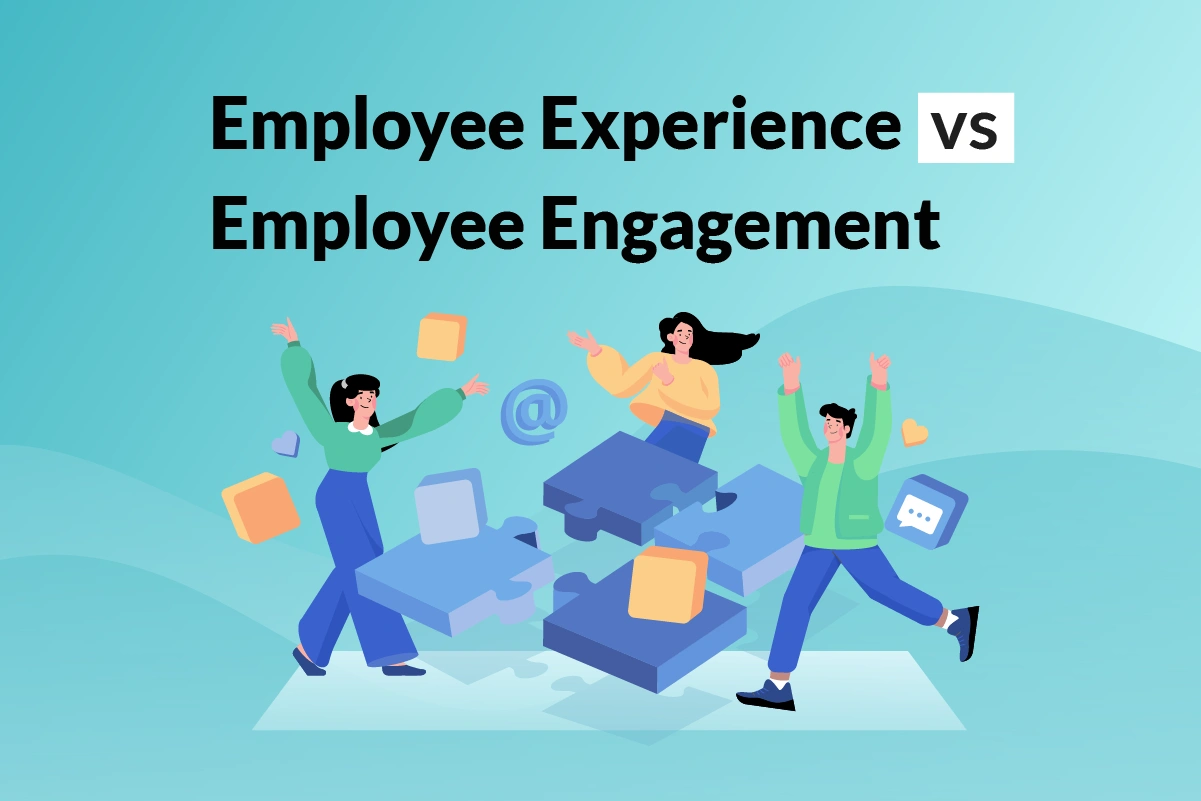Weaving a story of organizational success requires mastering the subtle art of balancing employee experience vs employee engagement.
Employee Experience encompasses the multifaceted interaction employees have with the company, including aspects like relationships, work achievements, and access to necessary tools. On the other hand, Employee Engagement pertains to a deep emotional connection between employees and their work, organization, and colleagues, marked by personal significance, pride, and a strong belief in the organization’s appreciation. It reflects in the dedication, energy, and proactive effort that engaged employees invest in their roles, making it distinct from the broader scope of Employee Experience.
These aren’t merely trendy HR terms. They are pivotal in sustainable growth and innovation. For the seasoned HR professional, the seasoned manager, or the avid organizational development student, understanding the dance between employee engagement vs employee experience is paramount. In a world championing diversity and advocating for working moms or flexible work conditions, this knowledge isn’t just valuable – it’s paramount for employee retention.
What is Employee Experience?
Employee experience encompasses the sum total of every interaction, feeling, and perception an employee has throughout their journey in an organization. It starts from the recruitment phase and extends beyond the employee’s exit. It encapsulates everything from the onboarding process, the work environment, growth opportunities, to how you celebrate success.
What is Employee Engagement?
Employee engagement pertains to the emotional connection and commitment an employee feels towards their organization. Engaged employee isn’t just satisfied with their job; they’re enthusiastic, motivated, and willing to put in discretionary effort for the company’s success. Different employee engagement models exist to measure and enhance this connection.
Employee Experience vs Employee Engagement: Key Differences
At first glance, employee engagement vs experience might seem like two sides of the same coin. However, truly understanding their distinct nature and impact can reshape how we approach workforce dynamics. Each plays a pivotal role in crafting a workplace where individuals thrive and businesses prosper.
Before we deep dive into their individual attributes, let’s lay out a clear, side-by-side comparison.
| Aspects | Employee Experience | Employee Engagement |
| Scope | The employee’s entire lifecycle. | Zeroes in on daily commitment and motivation. |
| Duration | From recruitment to post-exit. | Fluctuates frequently based on various factors. |
| Influencing Factors | Company culture, environment, growth opportunities, etc. | Immediate job satisfaction, managerial relationships, recognition, etc. |
| Measurement | Long-term metrics like retention rates and feedback at milestones. | Regular surveys, feedback sessions, and performance metrics. |
| Outcome Impact | Longer tenures, enhanced employer branding. | Higher productivity, teamwork, and reduced turnover. |
| Nature | Structural, relating to systemic aspects. | Emotional, related to the employee’s connection to the job and organization. |
This bird’s-eye view will help you, whether you’re an HR professional, a business leader, or an employee advocate, to harness the potential of both concepts, driving your organization towards unparalleled success.
Scope: Deep Dive into Experience vs. Engagement
The landscape of employee engagement and experience is broad, yet each term has its unique dimensions.
When considering employee experience, think of it as a panoramic view of an employee’s journey. It’s comprehensive, capturing every twist and turn of an employee’s time at your company. This includes their first interview, interactions with teammates, career advancements, and even their exit interview. Especially for groups like working moms, this might involve how flexibly they can integrate their work and personal lives or how inclusive their team environment feels.
On the other hand, employee engagement zeroes in on the here and now. It’s the pulse check, assessing how committed, passionate, and motivated an employee feels in their current role. It looks at how an employee approaches their daily tasks, collaborates with their team, or innovates. For those championing a diverse workforce, understanding this engagement level becomes crucial. Engagement taps into whether individuals, regardless of their background, feel valued, heard, and inspired daily.
Duration: Lifelong Memories vs. Present Moments
Employee experience is a marathon. It’s the culmination of numerous interactions, events, and impressions that an employee gathers over their entire journey with an organization. For a working mom, it might encapsulate the support she receives during her maternity leave, or for an employee advocate, the growth and learning opportunities over the years.
Flipping the coin side, employee engagement is a series of sprints. It’s unstable, changing with team dynamics, job roles, organizational shifts, and personal life events. An inclusive workplace might see surges in engagement after diversity training, while a sudden organizational change might challenge that momentum.
Influencing Factors: The Environment vs. The Heartbeat
When pondering the influencing factors behind employee experience vs engagement, one could visualize a garden.

Employee experience is influenced by the quality of the soil, the sunlight, and the tools at hand — in a corporate setting, this translates to company culture, work environment, technologies provided, growth opportunities, and especially work-life balance for demographics such as working moms.
Employee engagement, on the other hand, is the health of the plant itself. It thrives or wilts based on immediate job satisfaction, clarity of roles, relationships with peers and managers, and the nourishment of recognition and feedback. For those building a diverse workforce, fostering these positive influencers is pivotal.
Measurement: The Story vs. The Snapshot
In the discourse on employee experience vs engagement, measurement tactics vary significantly.
Employee experience, with its expansive scope, relies on long-term indicators. Think retention rates, internal promotions, or the qualitative feedback amassed during an employee’s tenure. It paints a holistic picture, shedding light on the organization’s strengths and areas of improvement.
Employee engagement, being dynamic, demands more frequent check-ins. Surveys, feedback sessions, and performance indicators become the tools of choice. They offer immediate insights, capturing the ebbs and flows of an employee’s enthusiasm and commitment.
Outcome Impact: Legacy vs. Daily Triumphs
The fruits of a positive employee experience are long-lasting. Employees with enriching experiences become brand ambassadors, even after they leave. They contribute to a powerful alumni network and boost employer branding. In essence, they leave a legacy.
The results of high employee engagement can also be immediate and tangible. Engaged employees drive productivity, foster incredible teamwork, and reduce absenteeism. They’re the champions who make daily victories possible and keep the company’s heart beating strong.
Nature: The Framework vs. The Feeling
At the heart of the discourse on employee experience vs engagement lies their intrinsic nature.
Employee experience is about the structure. It’s the skeletal framework, made up of policies, systems, and environmental facets of working in a company. It’s the path laid out for employees, ensuring they have the means to succeed.
Employee engagement is the spirit. It’s the emotional, personal connection an employee feels to their role and the broader organization. It’s the drive that gets them up in the morning, the pride they feel in their work, and the passion with which they champion company values.

All in all, these distinctions are not just academic; it’s foundational for those who have worked as HR professionals and organizational leaders, understanding this informs strategies, shapes policies, and most crucially, builds workplaces where every individual, from the intern to the CEO, feels valued, understood, and driven.
Crafting the Future: Balancing Experience and Engagement
Distinguishing the nuances between employee experience vs employee engagement might feel a bit like piecing together a puzzle. But when we get it right, the picture is rewarding: a team that’s both fulfilled and fiercely dedicated. In a world where working moms, diverse professionals, and others seek a blend of flexibility, understanding, and appreciation, tapping into these insights is more than just a smart move—it’s heart-centered leadership.
If you’re ready to take the next steps in fostering this balanced dynamic, Boulo Solutions is here for you. Whether you’re on the hunt for dynamic, diverse talent or aiming to ensure every new team member feels cherished from their first day, we’re here to guide and support. Start this transformative chapter by collaborating with us. After all, the magic lies in not just finding the right person, but in fostering the right environment.

